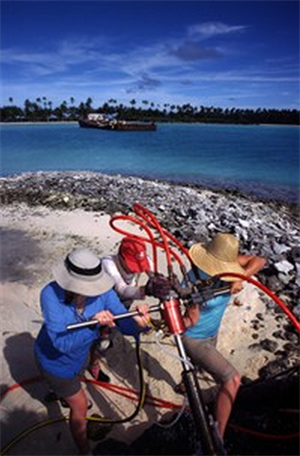Roz Pidcock
26.11.2014 | 6:00pmThe Pacific weather phenomenon known as El Niño has attracted a lot of attention this year as forecasters have puzzled over its ‘will it or won’t it’ behaviour.
In May, scientists were confidently predicting a 90 per cent chance of an El Niño materialising by the end of the year. But it’s proved elusive, with the odds of even a weak event dropping to 58 per cent earlier this month.
El Niño brings extreme rainfall to some parts of the world and drought to others. So predicting when one will make an appearance and how big the effects will be is important.
A new study just published in Nature uses a diverse array of different data sources, from corals to computer modelling, to unravel what’s been driving changes in El Niño over the past 21,000 years.
Pinning down this enigmatic phenomenon is tricky, the study concludes. But there’s reason to believe climate change could lead to stronger El Niño’s in the future, say the scientists.
El Niño and climate-readiness
Every five years or so, a change in the winds causes a shift to warmer than normal ocean temperatures in the equatorial Pacific Ocean – a phenomena known as El Niño.
Together, El Niño and its cooler counterpart La Niña are known as the El Niño Southern Oscillation (ENSO). Cycling between the two phases is responsible for much of the variation we see in global climate from one year to the next.
Knowing if and how climate change will affect El Niño and La Niña is an important scientific question, says Professor Kim Cobb, co-author on today’s paper. She told us recently:
“Preparing for large swings in temperature and rainfall is critical to adaptation strategies, especially if such variability will increase in the future.”
In theory, human-caused warming could increase the strength of ENSO events, Cobb continues:
“It is important to remember that climate change is much more than “global warming” â?¦ Because ENSO involves feedbacks between the wind strength, ocean temperature, and circulation, a change in any related climate parameter would arguably have some effect on ENSO strength”.
Deconstructing El Niño
Today’s paper is a comprehensive attempt to unravel all the factors influencing ENSO behaviour over the past 21,000 years – and to shed light on the impact rising carbon dioxide might have.
The scientists use a number of different approaches. For example, warmer ocean temperatures during El Niño cause a particular form of oxygen to build up in coral skeletons. Analysing the chemical makeup of fossilised corals can tell scientists a lot about the timing and strength of ENSO events during the coral’s lifetime.

Scientists use a drill to remove parts of the coral to analyse changes in rainfall and sea surface temperature. [ Image courtesy of Roland Klein, Norwegian Cruise Lines].
For the first time, the team also used a complex climate model to simulate changes over the past 21,000 years in key factors known to affect ENSO, including solar activity, greenhouse gases and ice sheet cover.
By combining these different strands of evidence, the scientists hope to unpick the biggest influences on past El Niño behaviour and how the effects of rising carbon dioxide compare.
Carbon dioxide’s effect is unclear
The scientists conclude that El Niño strength has varied a lot from one event to the next over the period studies. As well as the short term ups and downs, the scientists also spotted longer term patterns.
Proxy and model data all point to El Niño and La Niña getting about 15 per cent stronger over the past 11,000 years, during a period known as the Holocene. The shift towards stronger events was caused initially by changes in solar activity, then the atmosphere and ocean responded together in a way that amplified the change, the paper explains.
Compared to these other factors, changes in carbon dioxide had a smaller influence during the Holocene. This makes the influence of the gas on ENSO more difficult to pinpoint, lead author Professor Zhengyu Liu from the University of Wisconsin-Madison in the US tells us.
In the 15,000 years prior to the Holocene, changes in carbon dioxide would have had more influence, but proxy records are too short and sparse to say how with confidence, Liu adds.
Too soon to tell
The new study tentatively suggests El Niño and La Niña events should get weaker as carbon dioxide rises. But only about half of available climate models agree on this point, Liu tells us. The other half predict a shift towards stronger events as rising temperatures cause ice sheets to retreat, releasing pulses of meltwater, which have a boosting effect.
One thing scientists can say with confidence is that a warmer atmosphere holds more moisture. So when El Niño does bring rain to large parts of South America and the United States, it’s likely to fall in even heavier bursts in the future, increasing the risk of flooding.
As for this year’s El Niño, as we go into December the odds of it appearing by the end of the year are still hovering around 60 per cent. By coincidence, separate research out today describes how, after a strong start, the much anticipated 2012 El Niño abruptly disappeared.
So just as the jury’s still out on the impact of climate change on future El Niño and La Niña events, it would seem unwise to call this year’s event just yet either.
Source: Liu, Z. et L., (2014) Evolution and forcing mechanisms of El Nino over the past 21,000 years. Nature, doi: DOI: 10.1038/nature13963

